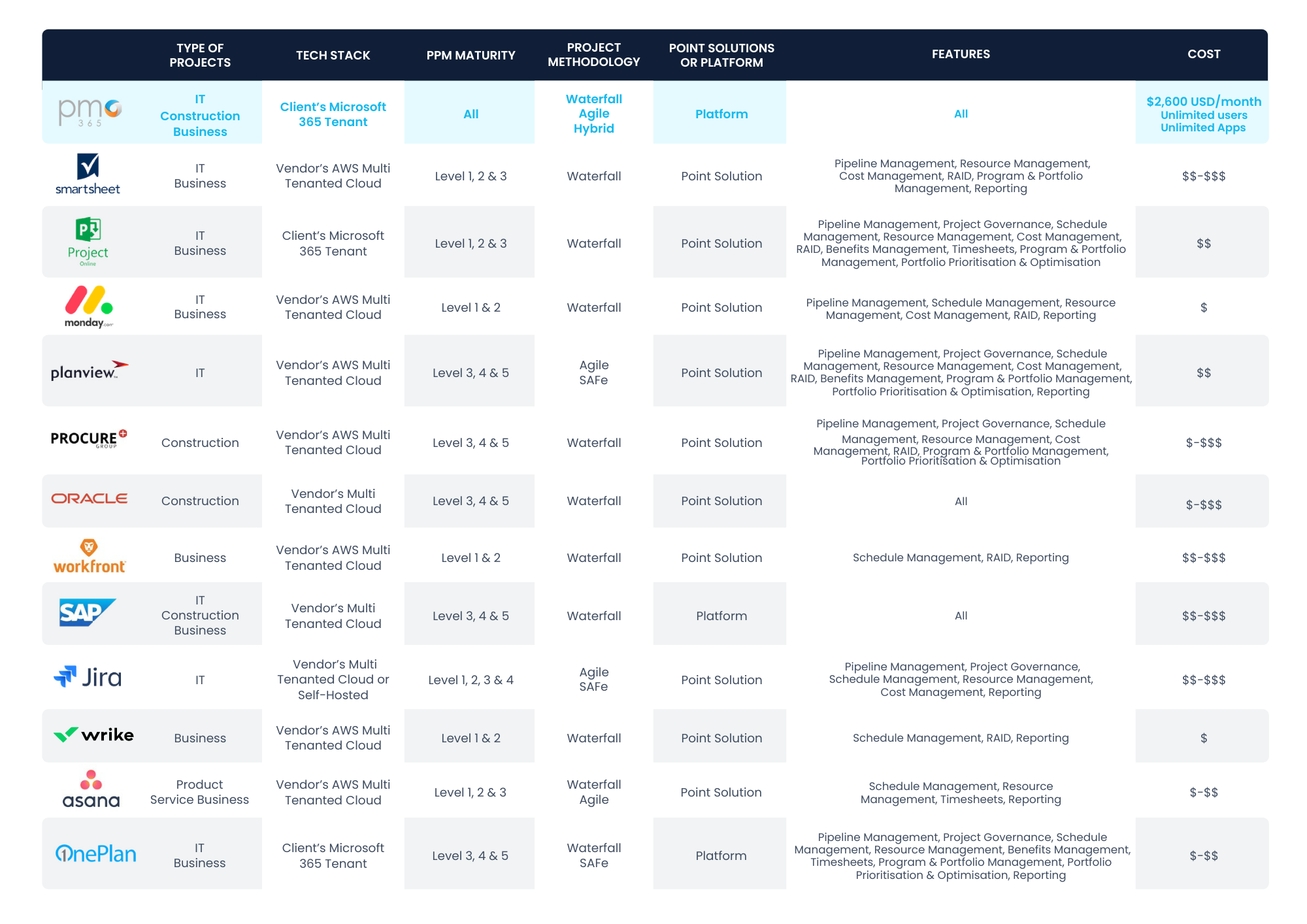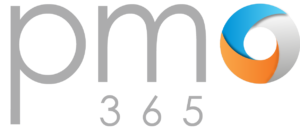What is a PPM solution?
A Project Portfolio Management (PPM) solution is a data-driven tool that helps manage and prioritise the large volume of varied work that exists within a large organisation.
A traditional PPM solution simply “supports the selection, planning and execution of a variety of different work packages or containers, including, but not limited to, traditional projects,” (Gartner) but a modern PPM solution will go much further.
“PPM leaders must reinvent PMO processes, embrace new ideas and enhance skill sets to support the digital direction of the CIO and CxOs, or risk being left behind.”
Joanne Kopcho, VP Analyst at Gartner
A modern PPM solution is designed to help PPM leaders optimise resources, across all projects and programs (structured into portfolios), in alignment with a company’s strategic and financial goals.
Smaller organisations with many different projects that have a significant amount of detail within each project also benefit from PPM, for instance in IT and construction.
PROJECT
A discrete unit of work that typically has defined goals, timelines, resources, and a budget. Projects may be small or short, large or long.
PROGRAM
A collection of projects and other work activities that have a permanent, ongoing common strategic business goal or area of work. Projects that grow too big, or will be ongoing for the foreseeable future, may be broken up to become a program.
PORTFOLIO
A collection of programs, projects, and other work activities that align with a business goal or goals. Organisations may group all of their work under one portfolio, or break these into goal-oriented or business unit-oriented sets.
A PPM solution allows a user to visualise all of the complete, in-progress, and to-do work within a company. Each of the units of work has a priority, category, assigned resources, budget, demand and capacity planning, and other project management capabilities. It’s also possible that different portfolios share the same projects, which then have pooled resources.
A PPM solution automates much of the approvals workflows and reporting across projects, allowing for real-time, data-driven decision-making at the highest level of the enterprise. PPM solutions are designed to effectively and efficiently align business operations with overarching business strategy, objectives, and investment.
Strategic Portfolio Management
is “a set of business capabilities, processes and supporting portfolio management technology to create a portfolio of strategic options that focus an organisation’s finite resources to execute the enterprise wide business strategy.”
What’s the difference between PPM and Project (or Work) Management software?
In recent years, generalist Project Management (PM) software, or Work Management software, has become the default standard in organisations of all sizes. These PM solutions focus on creating and managing standalone projects. It is possible to add and manage many different projects, but the software typically lacks the advanced capabilities of PPM software, to manage and shuffle resources across different projects. The software also lacks the data reporting to decide when and if to schedule new projects, in terms of business goals and current resourcing.
A PM solution is project-based and requires Project Managers to handle their own reporting, whereas a PPM solution is managed, with overarching resource orchestration, and real-time reporting across projects, programs, and portfolios.
Going from Project and Program Management to Portfolio Project Management is the maturation of data-led business management.
Often, organisations start with a PM solution, before:
|
The number of projects scales to become unmanageable |
> |
The organisation wants to mature its alignment of work to company goals | > | The organisation demands better resource management |
The company will then progress to a PPM solution.
“By 2025, 70% of digital investments will fail to deliver the expected business outcomes due to the absence of a strategic portfolio management (SPM) approach.”
2023 Magic Quadrant for Strategic Portfolio Management, Gartner
What are the benefits of a PPM solution?
In recent years, generalist Project Management (PM) software, or Work Management software, has become the default standard in organisations of all sizes. These PM solutions focus on creating and managing standalone projects. It is possible to add and manage many different projects, but the software typically lacks the advanced capabilities of PPM software, to manage and shuffle resources across different projects. The software also lacks the data reporting to decide when and if to schedule new projects, in terms of business goals and current resourcing.
Consistency
By offering a real-time overview of all the operational data within a business, stakeholders will have rich, correct, up-to-date insights at all times.
Single source of truth for business data
While the amount of tools that businesses use continues to grow, there is now a mandate for integration to achieve data singularity across systems. A PPM solution is a critical piece of tooling to extract data and meaning across projects, programs, and portfolios, and their various systems, plus adding extra value to that data.
Collaborative work in one place, while ensuring information security by user group and level access permissions
With a PPM solution, Project, Program and Portfolio Managers, and other relevant business stakeholders will all be able to work collaboratively within one tool, while gaining their relevant insights.
Not all users should have access to the organisation’s full PPM capabilities, which is why a PPM solution must have full integration with a company’s Identity and Access Management solution, for user and group-level data exploration.
Accurately report to investors or stakeholders on the state of various portfolios
Timeliness is critical in data reporting for a company. It’s no longer good enough to wait for a quarterly report or ask internal analysts to generate figures and wait for an outcome. Instead, a PPM offers real- time insights for investors or stakeholders.
"73% of finance functions favor a centralised, tightly governed source for data”
Make Financial Data Decision-Ready, Gartner
Real-time visibility
PPM software brings real-time visibility to all key business drivers across the organisation, at the project, program, portfolio, and whole-of-business levels, with the ability to drill down as needed. Project, Program, and Portfolio Managers must follow PPM governance processes to ensure the validity of dashboards.
Portfolio, program, and project alignment to business goals
All work initiatives within an organisation must be aligned with business goals or strategic objectives to realise value. PPM solutions help to visualise this link in real-time to understand which projects, programs, and portfolios will take priority.
Demand and capacity planning across the business
By visualising the demand and capacity of resources across the business, organisations gain a greater understanding of where resources are required and when, and whether certain projects are worth prioritising.
Risks and issues across the business
Risk and issue management is often integrated under PPM. All risks and issues may be visualised and tracked by category, cost and cost exposure, project owner, consequence type, impact, probability, etc. Risk reaction plans can be detailed.
Budgets across the business
With the right views, it’s possible to see when and where money is being spent across the business, to inform budgeting. Discover budget breakdowns and high-level overviews by cost type, resource, item code, time-based, etc.
Timelines across the business
Because a PPM solution is project-based, visibility may be gained into timelines across the business, that can be filtered, aggregated, and segmented to get deeper insights into how and where time is spent.
Other resourcing across the business
PPM solutions can also cover other types of resourcing such as materials, services, and contracting, typically with the same degree of detail as other reportable streams of data.
"73% of finance functions favor a centralised, tightly governed source for data”“Intangible losses that might be avoided in projects through improved P3M performance and the reduction of benefits leakage may be as high as 25-50%, with the avoidance of complete failure in some instances.”
Portfolio, Programme and Project Management Capabilities in Government, KPMG
Insights
A PPM solution offers a deeper level of insight into how a business is historically, currently, and projected to perform operationally.
Align strategy with resources, scheduling, project delivery, and expectations
A PPM solution gives organisations a chance to truly realise the value of projects, programs, and portfolios by aligning them to business value. This is achieved by a range of sophisticated project prioritisation tools, in-app strategy assessments and ratings, and the ability to conduct portfolio analyses.
Investigate timelines
Within a PPM solution, Portfolio Managers can look at specific timelines on projects or programs, investigate the potential causes of lag, and decide whether to add further resourcing. There is also the chance to investigate historical and future resource timelines by resource or collectively.
Decrease operational risk
By gaining at-a-glance real-time insight into areas like resourcing, scheduling, and budgeting, Portfolio Managers and other stakeholders can develop strategies to decrease operational risk moving forward. A PPM solution may also incorporate actual risk management capabilities, for example, risk tracking across projects.
Prioritisation
A PPM solution should offer advanced prioritisation calculations for projects, budgets, resources, etc. so that businesses can make the right strategic, data-lead decisions.
Accurately prioritise portfolios, programs, projects
With the ability to score the business value of a particular project, and then perform aggregations across programs and portfolios, it becomes clear which projects to do next, assign more budget and resources, etc.
Optimise costs based on business goals/strategy
In selecting projects to fund, advanced scoring capabilities will help to choose the best possible combination of projects that will deliver the greatest value to the business, all within attributed program and portfolio budgets.
Optimise resource allocation
In scheduling new projects, resources can be assigned based on both available funds and resource availability. Likewise, other resourcing can be attributed to projects based on cost, category, priority, etc.
"(A PPM) maximises the value of the entire portfolio of projects to get the “most bang for the buck.” Taken together, the projects must have a high return on the organization’s investment”
Project Portfolio Management, Jeff Oltman
How to choose the right PPM solution?
Some PPM solutions are better suited to certain types of projects than others. For instance, there are speciality PPM solutions for highly technical fields, to accommodate typical projects in these industries, or industry-specific additional PPM modules to purchase. Industries include IT, construction, financial services, healthcare, education, etc.
Unlike other PPM solutions, pmo365 is a platform that offers specialised Apps for different types of projects, like IT, construction or business projects.
IT
PPM for IT projects will contain a variety of tools designed for prioritising software, IT infrastructure, or IT services demand based on the strategic value of projects to the organisation. When used in software development tasks, PPM must integrate with iterative project delivery methodologies and tools such as Agile SCRUM, SAFe, Jira, and ServiceNow.
pmo365’s ICT Works app is tailored specifically for IT and ICT businesses, or functions within the business.
CONSTRUCTION
PPM for construction projects will contain a variety
of tools for use in tracking, visualising, utilising, and approving construction artefacts such as design drawings, contracts, and detailed cost management of physical assets.
pmo365’s Capital Works app is tailored specifically for construction businesses, or functions within the business.
BUSINESS
PPM for business projects will contain tools for use in tracking and visualising business targets, progress, and strategy across a wide variety of industries including professional services and product-led businesses, as well as those that house multiple business lines under one or more portfolios.
pmo365’s traditional PPM app is used by businesses of all different types and industries for effectively managing PPM within their business.

02 Current tech stack (underlying infrastructure, tools, and data sources
Unless you are prepared to migrate to new infrastructure, tools, and data sources, a PPM solution should integrate as seamlessly as possible into your current systems. Working within your ecosystem is far easier, faster, and more cost-effective than rolling out a whole new system. The PPM itself will need to be housed somewhere, will it be onsite, in the cloud, or is it vendor-locked? Do you already have a robust project management solution or ERP software you’d prefer to integrate rather than input?
pmo365 integrates directly into Microsoft 365, namely it uses Power Apps and Power BI. pmo365 is built on the Microsoft Power Platform, so it fits in right alongside your Microsoft management apps, services, and architecture.
03 PPM maturity level
Gartner proposes a Program and Portfolio Management Maturity Model that organisations can follow to gauge their enterprise level of maturity in portfolio management and business goal alignment. The good news is that a PPM solution can be implemented
at any level of PPM maturity, and can help an organisation mature to the next level. At later levels of maturity, a PPM facilitates a more rapid advancement to the next level by implementing key features of the PPM and successfully leveraging its insights.
pmo365 is suitable for organisations at any level of Program and Portfolio Management maturity.
|
MATURITY LEVEL 1: REACTIVE At the Level 1, Reactive state, all of the business internal processes are centred around critical project management and projects have estimated budgets but no formal management tools. |
|
|
MATURITY LEVEL 2: EMERGING DISCIPLINE At the Level 2, Emerging Discipline state, project processes are standardised, a Project Management Office is established, projects are aligned with overall business strategy, and projects and programs are prioritised. |
|
|
MATURITY LEVEL 3: INITIAL INTEGRATION At the Level 3, Initial Integration state, there are now PPM leader roles, cross-functional groups are easy to form and collaborate, programs are managed in-house, and career paths are defined. |
|
|
MATURITY LEVEL 4: EFFECTIVE INTEGRATION At the Level 4, Effective Integration state, centres of competency improve workload management, the portfolio is modeled and appropriately optimised factoring in risk, and benefit realisation is being tracked. |
|
|
MATURITY LEVEL 5: EFFECTIVE INNOVATION At the Level 5, Effective Innovation state, change operations allow for a constant stream of mini-projects, rapid strategy execution is the default for enterprise programs, and change management and communications are ingrained at the core of the Enterprise Project management Office. |
04 Project methodology
Not all projects follow the same project methodology and not all PPMs can truly support different project methodologies. For instance, while some solutions might advertise that they support Agile, in reality, the capability may be inadequately integrated, or only available with extra custom-built add-ons. If you follow something other than the Waterfall project methodology for some or all of your projects, make sure to understand the full capabilities of the solution and how its integrations work, given your requirements.
pmo365 works with Agile, Waterfall and Hybrid project methodologies, available through integration with the world’s most popular project management solutions.
WATERFALL METHODOLOGY
The Waterfall methodology is a traditional approach to all types of projects that moves through the different stages in a linear way: one stage is complete before the next begins. These stages are usually Initiation, Planning, Execution, Closure, and Post-Closure.
HYBRID METHODOLOGY
With the hybrid methodology, Waterfall practices are used for known and predictable project work areas, whereas Agile principles can apply for less- certain parts of the project. The hybrid methodology is both flexible and demonstrably proven in its approach.
AGILE METHODOLOGY
Agile is a newer project management approach that, instead of looking at a project as a whole, breaks down a project into sprints. Each sprint instead follows a plan, design, develop, test, deploy, and review cycle, so that a whole component or problem space can be completed at once. It is an iterative method, where the lessons learned follow into the next sprint. Agile was designed to alleviate the common problem of software projects blowing out in scope and budget.
SAFe METHODOLOGY
SAFe is the Scaled Agile Framework methodology that gives a structured way for businesses to scale while following the Agile principles. Other scaled Agile methodologies include Scrum@Scale and Large Scale Scrum.

05 Point solution vs platform
Many organisations have already invested a significant resources into particular point solutions, such as Enterprise Resource Planning (ERP) solutions, financial systems, and project management tools. While these tools all may generate useful, real-time reports, what’s lacking is a single place where this information can all be accessed in real-time.
Some organisations will build their own over-the-top solution to aggregate reporting, or simply send reports via email on a regular basis. These types of point solutions will only get a business so far. When a more complex aggregation of whole-of-business reporting aligned to business values is required, a platform that integrates all these systems and utilises the data within is required.
pmo365 is a PPM platform that integrates with over 1000 point solutions.
06 Features in a PPM solution
PIPELINE MANAGEMENT
Before a project even begins, it has a lifecycle from ideation to proposal, budgeting, approval and then commencement. Pipeline management will cover project ideation, opportunity management, work in-take processes, and decision gates, to decide which projects are ultimately worth taking on for the business, and which projects will take priority.
PROJECT GOVERNANCE
Project governance demands clearly defined roles, responsibilities, accountabilities, decision-making processes, systems of work, risks and issue processes, and QA programs within and across each project before it even begins. By detailing a project governance framework across a project’s initiation, planning, delivery, and closure and handover, along with the gates between stages, it means that all stakeholders have a point of reference for how work is to be done and the processes throughout.
SCHEDULE MANAGEMENT
A PPM solution should have both Schedule Planning, (with a Work Breakdown Structure, work packages and activities, logic and dependencies, and resourcing), and Schedule Management (with a schedule baseline plus monitoring and reporting). This should also give flexibility to integrate other scheduling solutions and Agile workflows.
RESOURCE MANAGEMENT
Resource management looks at the bigger picture of how much time and money are spent per employee, which can then be considered by role, skills, department, and other divisions. By aggregating resources, it’s possible to see where, when, and how resources are assigned for demand and capacity planning, plus future projections. A detailed overview like this also makes it possible to anticipate hiring and change needs.
COST MANAGEMENT
To perform accurate cost management, PPM software needs to track original and current project budget estimates, perform automatic forecasting based on current projections, and track actual costs across time. Post-project, these figures can feed back into estimations for new projects.
RAID (RISKS, ASSUMPTIONS, ISSUES, DEPENDENCIES) LOGS
Project risks and issues with associated probabilities, impact ratings, response strategies, and actions, plus task interdependencies and task or project assumptions should be logged and tracked in real-time to help add context to a project. By having built-in mechanisms to identify, catch, and remediate these potential impacts on a project, there is less chance for unidentified project derailment.
BENEFITS MANAGEMENT
Within each project, there should be the opportunity to add benefits management. Benefits management is designed to ensure specific projects are aligned with program or portfolio goals. A project may have multiple benefits, which must be specific, measurable, trackable and relevant to overarching goals.
Example: Marketing will increase sales by 25% by 30 June
With an overview of all projects’ benefits, it’s possible to determine project prioritisation, and a plan to realise all these benefits. A post-project review of benefits management can determine ROI and inform future projects.
TIMESHEETS
Tracking employee timesheets is essential for human resource management. By tracking hours worked by role, business function, project, and task, timesheets can feed back into project and productivity tracking via tooling like Gantt tasks and activities. In turn, this can inform resourcing supply, demand, and costing via Earned Value. With timesheet reporting, this helps inform budgets, timelines, progress, and priorities.
CONTRACT AND PROCUREMENT MANAGEMENT
A PPM solution must have a function that helps manage materials and services procurement and contracting for visibility, tracking and automation across projects. Using a PPM framework, contracts and spending can be attributed to project, portfolio and business objectives.
PROGRAM & PORTFOLIO MANAGEMENT
Program and portfolio management makes it possible to coordinate multiple associated projects in a managed, repeatable, way. Program management considers each project’s benefit to the business, over the budgeting and time constraints that project management focuses on. Program management coordinates the planning, estimation, resourcing, etc., of all projects under one program, for a detailed overview and orchestration. Portfolio management does this at the level above; managing multiple programs.
PORTFOLIO PRIORITISATION AND OPTIMISATION
Portfolio analysis comes when examining a full portfolio, typically each year, to see where budgets should be allocated, and which projects need a rethink. To be able to do portfolio planning, each project or initiative’s value to (and impact on) the business, or given business goal must be determined. This will lead to a list of prioritised projects which can then be examined and considered alongside the cost of each. Within the bounds of the portfolio’s budget, projects can be chosen to maximise the strategic value to the business as well as the budgeting constraints.
REPORTING
A PPM solution will provide a considerable number of in-built reports and dashboards across all levels of the tool, reporting on the health of all business systems as well as providing future modelling capabilities. The tool should allow degrees of customisation for report generation, including filters and visual formatting, and may even offer advanced analytics capabilities for power users.
pmo365 is a PPM platform that integrates with over 1000 point solutions.
06 Cost
Cost will always be a consideration for any business purchase, regardless of how large your budget is. Most PPM solutions are offered on a subscription basis, as a service. These subscriptions are typically charged at a yearly rate, often with additional subscription costs for speciality modules. Solutions are usually charged per seat or user, or with tiers aligning to business size in some other way. There may be different pricing for hosted or self-hosted solutions. You’ll also encounter other pricing models, like flat-rate monthly subscriptions tiered by levels of functionality. Rarely, software has a one-off cost, with additional costs for new modules. Be wary of any free or freemium solutions, as these can tend to embed early adopters before prices climb.
pmo365 offers fixed-price month-to-month subscription, with all Apps included and for unlimited users, integrations, and data sources.

